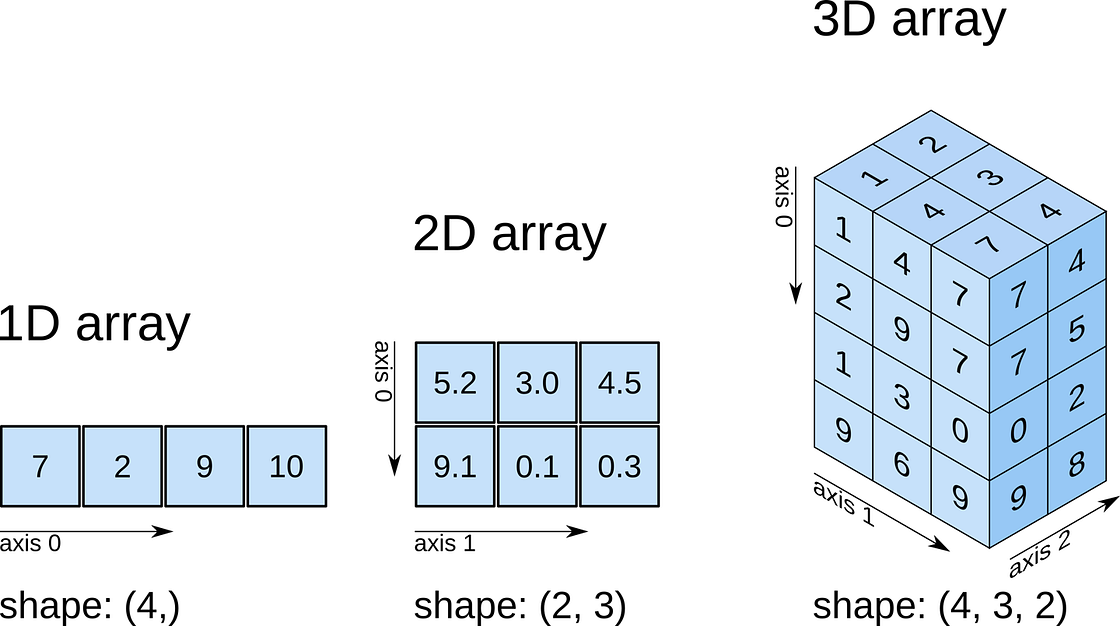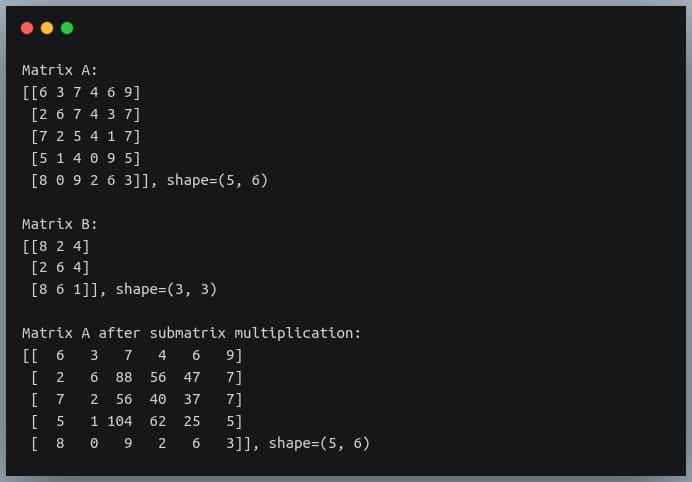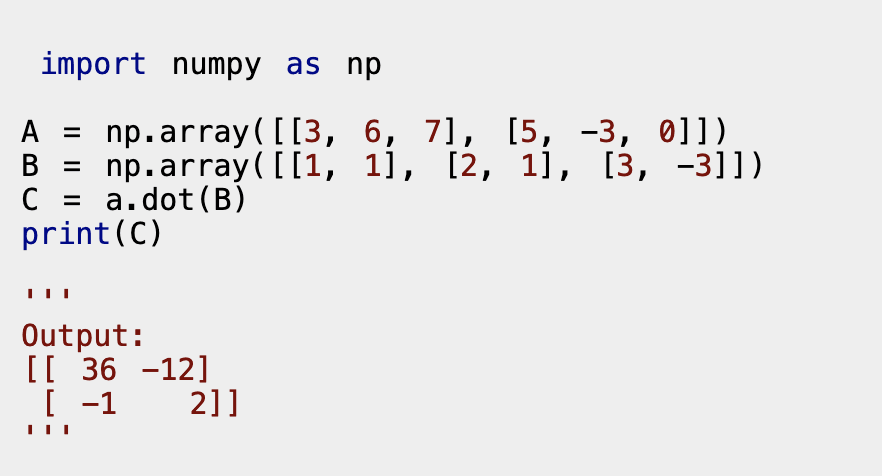Python Matrix Multiplication Along Axis
The number of columns in the matrix should be equal to the number of elements in the vector. In Python we can multiply two sequences with a list comprehension.

Numpy The Absolute Basics For Beginners Numpy V1 21 Manual
Numpydot is the dot product of matrix M1 and M2.

Python matrix multiplication along axis. To multiply them will you can make use of the numpy dot method. Npexpa Sine function of all element in a. Ptp axis out Peak-to-peak maximum - minimum value along the given axis.
Apply operation row-wise across all columns for each row. Lets make this concrete with a worked example. If both a and b are 2-D arrays it is matrix multiplication but using matmul or a b is preferred.
Sum axis dtype out Returns the sum of the matrix elements along the given axis. So to move along the axis-1 four values 8bytes x 4 32 bytes are jumped while moving along the axis-0 eight values 8 bytes x 8 64 bytes is jumped. Numpy offers a wide range of functions for performing matrix multiplication.
Npsubtractab or a-b Element-wise multiplication of a and b. The numpyapply_along_axis function helps us to apply a required function to 1D slices of the given array. I have an A matrix of dimensions N N and a vector b of dimension m.
Each element of this vector is obtained by performing a dot product between each row of the matrix and the vector being multiplied. 1d_func ar args. The transpose of a matrix is calculated by changing the rows as columns and columns as rows.
Npaddab or ab Subtracting the two arrays a and b. Repeat repeats axis Repeat elements of an array. Swapaxes axis1 axis2 Return a view of the array with axis1 and axis2 interchanged.
Setting the axisNone when performing an operation on a NumPy array will perform the operation for the entire array. On the execution of the function transpose - arrtranspose1 0 2. Multiplication of two Matrices in Single line using Numpy in Python Matrix multiplication is an operation that takes two matrices as input and produces single matrix by multiplying rows of the first matrix to the column of the second matrixIn matrix multiplication make sure that the number of rows of the first matrix should be equal to the number of columns of the second matrix.
The main objective of vectorization is to remove or reduce the for loops which we were using explicitly. Npsina Squareroot of all element in a. Npmultiplyab or ab Matrix wise multiplication of a and b.
Multiplication of two matrices X and Y is defined only if the number of columns in X is equal to the number of rows Y. Put indices values mode Set aflatn valuesn for all n in indices. If you try this with its a ValueError This would work for matrix multiplication npones3 2 npones2 4.
Adding the two arrays a and b. Ravel order Return a flattened matrix. A core feature of matrix multiplication is that a matrix with dimension m x n can be multiplied by another with dimension n x p for some integers m n and p.
A 1 2 3 4 5 b 6 7 8 9 10 x y for x y in zipa b 6 14 24 36 50 This is fine for smaller data. However it is not as efficient as vectorizing the multiplication with NumPy. Numpydot handles the 2D arrays and perform matrix multiplications.
By reducing for loops from programs gives faster computation. If you wish to perform element-wise matrix multiplication then use npmultiply function. I am using numpy to perform some mathematical calculations in Python.
Std axis dtype out ddof Return the standard deviation of the array elements along the given axis. And if you have to compute matrix product of two given arraysmatrices then use npmatmul function. Npdotab Exponential of all elements in a.
In Python the process of matrix multiplication using NumPy is known as vectorization. Npsqrta Zeros Matrix. Return the product of the array elements over the given axis.
I would like to multiply A by b so as to obtain a tensor. If a is an N-D array and b is a 1-D array it is a sum product over the last axis of a and b. The result of a matrix-vector multiplication is a vector.
If X is a n x m matrix and Y is a m x l matrix then XY is defined and has the dimension n x l but YX is not defined. The dimensions of the input matrices should be the same. Here are a couple of ways to implement matrix multiplication in Python.
If either a or b is 0-D scalar it is equivalent to multiply and using numpymultiply a b or a b is preferred. The build-in package NumPy is. Works on 1-D arrays where ar is 1D slice of arr along axis.
We will sum values in our array by each of the three axes.

Numpy Matrix Multiplication Np Matmul And Ultimate Guide Finxter

Matrix Multiplication Data Science Pinterest Multiplication Matrix Multiplication And Science

How To Calculate The Average Of A Numpy 2d Array Finxter

Numpy The Absolute Basics For Beginners Numpy V1 21 Manual

Numpy The Absolute Basics For Beginners Numpy V1 21 Manual

2 Manipulating And Plotting Data In Python Numpy And Matplotlib Libraries Ucl Geography Level 7 Course Scientific Computing 1 0 Documentation

How To Calculate The Standard Deviation In Numpy Finxter

20 Examples For Numpy Matrix Multiplication Like Geeks

Tensor Multiplication With Numpy Tensordot Stack Overflow

Numpy Matrix Multiplication Numpy V1 17 Manual Updated

Numpy Matrix Multiplication Javatpoint

Numpy Dot Example Np Dot In Python Matrix Multiplication Crash Course Basic Concepts
Numpy Matrix Multiplication Numpy V1 17 Manual Updated

Python Ambiguity In Pandas Dataframe Numpy Array Axis Definition Stack Overflow

Vectorizing Multiplication Of Matrices With Different Shapes In Numpy Tensorflow Stack Overflow


